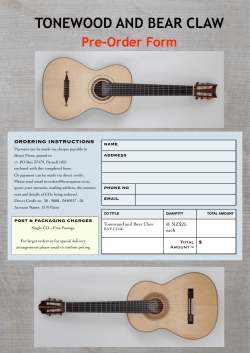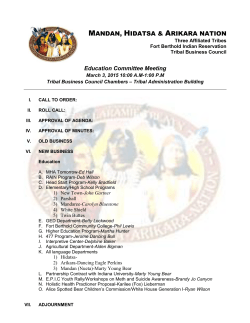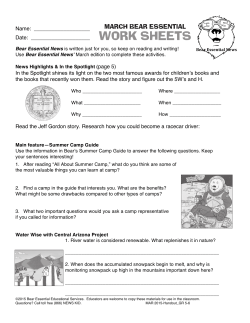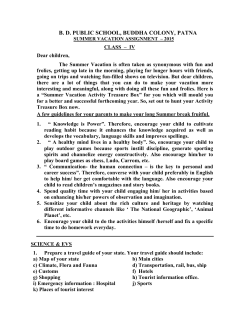
RPC and REST
1
Introduction
2
Remote Procedure Call (RPC) is a high-level model for
client-sever communication.
#06
RPC & REST
mechanism for building distributed systems.
CLIENT/SERVER COMPUTING AND WEB TECHNOLOGIES
RPC Model
3
client
request
Examples: File service, Authentication service.
Characteristics
server
Call procedure and
wait for reply
It provides the programmers with a familiar
The called procedure is in another process which
may reside in another machine.
The processes do not share address space.
Receive request and start
process execution
reply
Send reply and wait for next
execution
Resume
execution
Blocking state
Features
5
Passing of parameters by reference and passing
pointer values are not allowed.
Parameters are passed by values.
The called remote procedure executes within the
environment of the server process.
Executing state
The called procedure does not have access to the
calling procedure's environment.
No message passing or I/O at all is visible to the
programmer.
Limitations
Simple call syntax
Familiar semantics
Well defined interface
Ease of use
overheads) can be significantly (1 - 3 orders of magnitude)
Efficient
slower than that for local procedure.
Can communicate between processes on the
same machine or different machines
Parameters passed by values only and pointer values are not
allowed.
4
Speed: remote procedure calling (and return) time (i.e.,
Failure: RPC is more vulnerable to failure (since it involves
communication system, another machine and another
process).
The programmer should be aware of the call semantics, i.e.
programs that make use of RPC must have the capability of
handling errors that cannot occur in local procedure calls.
6
Design Issues
Design Issues
Exception handling
7
Necessary because of possibility of network and
nodes failures;
Delivery guarantees
assumed to have failed;
Duplicate filtering : when retransmission are used,
whether to filter out duplicates at the server;
Syntactic → achievable, exactly the same syntax as
a local procedure call;
Retry request message: whether to retransmit the
request message until either a reply or the server is
RPC uses return value to indicate errors;
Transparency
8
Semantic → impossible because of RPC limitation:
failure (similar but not exactly the same);
Retransmission of replies: whether to keep a history
of reply messages to enable lost replies to be
retransmitted without re-executing the server
operations.
RPC Components
9
Client
int caller()
Client stub
P1
(“client”)
Communication module
Dispatcher
Communication Module:
Forwards requests and replies
to appropriate hosts
Different architectures use different ways of
representing data
Caller (and callee) process uses its own platformdependent way of storing data
Middleware has a common data representation
(CDR) which is platform-independent
Caller process converts arguments into CDR format
Callee process extracts arguments from message
into its own platform-dependent format
Called “Marshalling”
Called “Unmarshalling”
Return values are marshalled on callee process and
unmarshalled at caller process
11
Code for remaining components all generated
automatically from function signatures (or object
interfaces in Object-based languages)
E.g., Sun RPC system: Sun XDR interface
representation fed into rpcgen compiler
These components together part of a Middleware
system
Server stub: calls callee(),
allows it to return a value
E.g., CORBA (Common Object Request Brokerage
Architecture)
E.g., Sun RPC
E.g., Java RMI
JSON-RPC
10
Programmer only writes code for caller function
and callee function
Dispatcher: Selects which
server stub to forward request
to
Marshalling
int callee()
Allows same caller() code to be
used for LPC and RPC
Server
Server stub
P2
(“server”)
Client stub: has same function
signature as callee()
Communication module
Generating Code
Remote procedure call protocol encoded in JSON.
It is a very simple protocol (and very similar to XMLRPC), defining only a handful of data types and
commands.
Allows for notifications (data sent to the server that
does not require a response)
Multiple calls to be sent to the server which may be
answered out of order.
Invoked by sending a request to a remote service
using HTTP or a TCP/IP socket (starting with version
2.0).
12
Example: adding
13
REST and HTTP
server.js
var rpc = require('json-rpc2');
var server = rpc.Server.$create();
function add(args, opt, callback) {
callback(null, args[0] + args[1]);
}
client.js
var rpc = require('json-rpc2');
var client = rpc.Client.$create(8000,
'localhost');
>> npm install json-rpc2
The motivation for REST was to capture
the characteristics of the Web which
made the Web successful.
server.expose('add', add);
server.listen(8000, 'localhost');
// Call add function on the server
client.call('add', [1, 2],
function(err, result) {
console.log('1 + 2 = ' + result);
}
);
Main Concepts
15
Nouns (Resources)
unconstrained
i.e., http://example.com/employees/12345
URI Addressable resources
HTTP Protocol
Make a Request – Receive Response – Display
Response
Exploits the use of the HTTP protocol
beyond HTTP POST and HTTP GET
HTTP PUT, HTTP DELETE
Resources
The key abstraction of information in REST is a
resource.
A resource is a conceptual mapping to a set of
entities
Any information that can be named can be a
resource
REST
Representations
constrained
i.e., XML
Verbs
Represent the actions to be performed
on resources
HTTP GET
HTTP POST
HTTP PUT
HTTP DELETE
17
16
Verbs
constrained
i.e., GET
14
a document or image
a temporal service (e.g. "today's weather in Los
Angeles")
a collection of other resources
a non-virtual object (e.g. a person)
Represented with a global identifier (URI in HTTP)
http://www.boeing.com/aircraft/747
HTTP GET
18
How clients ask for the information they seek.
Issuing a GET request transfers the data from the
server to the client in some representation
GET http://localhost/books
GET http://localhost/books/ISBN-0011021
Retrieve all books
Retrieve book identified with ISBN-0011021
GET http://localhost/books/ISBN-0011021/authors
Retrieve authors for book identified with ISBN-0011021
HTTP PUT, POST, DELETE
19
POST http://localhost/books/
Content: {title, authors[], …}
Creates a new book with given properties
Representations
How data is represented or returned to
the client for presentation.
Two main formats:
JavaScript Object Notation (JSON)
XML
It is common to have multiple
representations of the same data
PUT http://localhost/books/isbn-111
Content: {isbn, title, authors[], …}
Updates book identified by isbn-111 with submitted properties
DELETE http://localhost/books/ISBN-0011
20
Delete book identified by ISBN-0011
Why is it called
21
Architecture Style
22
"Representational State Transfer"?
http://www.boeing.com/aircraft/747
Response
(XML doc)
Resource
Client
Fuel requirements
Maintenance schedule
...
Request
(XML doc)
The Client references a Web resource using a URL. A representation of the resource is returned (in
this case as an HTML document).
The representation (e.g., Boeing747.html) places the client application in a state. The result of the
client traversing a hyperlink in Boeing747.html is another resource accessed. The new representation
places the client application into yet another state. Thus, the client application changes (transfers) state
with each resource representation --> Representation State Transfer!
Example: REST for bears
HTTP Verb
23
Description
/api/bears
GET
Get all the bears.
/api/bears
POST
Create a bear.
/api/bears/:bear_id
GET
Get a single bear.
/api/bears/:bear_id
PUT
Update a bear with
new info.
/api/bears/:bear_id
DELETE
Delete a bear.
PO
(XML doc)
URL 1
HTTP Response
HTTP POST
Response
(JSON doc)
Boeing747.html
Route
HTTP GET
URL 1
HTTP Response
HTTP DELETE
Response
(TEXT doc)
doGet()
Web/Proxy Server
Request
(XML doc)
doPost(id)
REST Engine
(locate resource
and generate
response)
URL 1
HTTP Response
Example: Create a bear
var
var
var
var
doDelete()
express = require('express');
app = express();
router = express.Router();
bodyParser = require('body-parser');
var bears = [];
router.route('/bears')
.post(function(req, res) {
var bear = {};
bear.name = req.body.name;
bears.push(bear);
res.json({ message: 'Bear created!' });
});
// all of our routes will be prefixed with /api
app.use('/api', bodyParser.json(), router);
app.listen(8000);
24
Try REST API
25
Chrome plugins with REST clients functionality are
available. e.g., Postman, DHC
Angular $http
26
<body ng-controller="BearCtrl">
<input type="text" ng-model="bear.name">
<input type="number" ng-model="bear.weight">
<button ng-click="add()">Add</button>
</body>
<script type="text/javascript">
angular.module("bearApp", [])
.controller("BearCtrl", function($scope, $http){
$scope.add = function(){
$http.post("/api/bears", $scope.bear).
success(function(data){
console.log(data.message);
$scope.bear = {};
});
}
})
</script>
Angular Resource
27
<body ng-controller="BearCtrl">
<ul>
<li ng-repeat="bear in bears">{{bear.name}}</li>
</ul>
</body>
<script type="text/javascript">
angular.module("bearApp", ["ngResource"])
.controller("BearCtrl", function($scope, $resource){
var Bear = $resource('/api/bears/:bear_id',
{bear_id: '@id'});
<script type="text/javascript">
angular.module("bearApp", ["ngResource"])
.controller("BearCtrl", function($scope, $resource){
var Bear = $resource('/api/bears/:bear_id',
{bear_id: '@id'});
$scope.bears = Bear.query();
})
</script>
$scope.add = function(){
var givenBear = new Bear($scope.bear);
givenBear.$save(function(data){
console.log(data.message);
$scope.bear = {};
});
};
})
</script>
>> Requires the ngResource module to be installed.
References
"Advanced Operating Systems: RPC", Ajay Katangur
"RPCs and Concurrency Control", Indranil Gupta, 2014
"JSON-RPC", http://en.wikipedia.org/wiki/JSON-RPC
"Node-jsonrpc2", https://github.com/pocesar/node-jsonrpc2
29
"Representational State Transfer (REST):
Representing Information in Web 2.0 Applications", Emilio F Zegarra
"Build a RESTful API Using Node and Express 4",
https://scotch.io/tutorials/build-a-restful-api-using-node-and-express-4
"Express Routing", http://expressjs.com/guide/routing.html
"$resource",
https://docs.angularjs.org/api/ngResource/service/$resource
Angular Resource
28
© Copyright 2025









